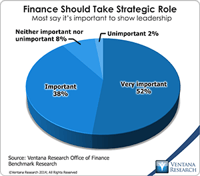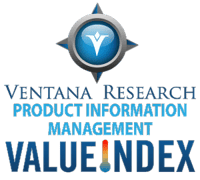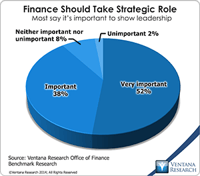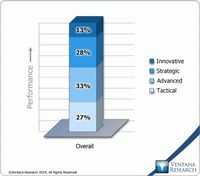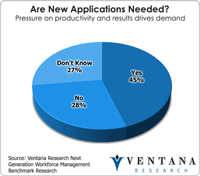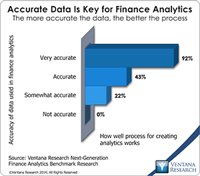SYSPRO is a 35-year-old software vendor that focuses on selling enterprise resource planning (ERP) systems to midsize companies, particularly those in manufacturing and distribution. In manufacturing, SYSPRO supports make, configure and assemble, engineer to order, make to stock and job shop environments. The company attempts to differentiate itself through vertical specialization and its years of ongoing development, which can reduce the need for customization and cut the cost of initial and...
Read More
Topics:
Big Data,
SaaS,
ERP,
Governance,
Human Capital Management,
Office of Finance,
close,
Continuous Accounting,
Analytics,
CIO,
Cloud Computing,
Collaboration,
CFO,
CRM,
CEO
The imperative to transform the finance department to function in a more strategic, forward-looking and action-oriented fashion has been a consistent theme of practitioners, consultants and business journalists for two decades. In all that time, however, most finance and accounting departments have not changed much. In our benchmark research on the Office of Finance, nine out of 10 participants said that it’s important or very important for finance departments to take a strategic role in...
Read More
Topics:
Big Data,
Planning,
Predictive Analytics,
Social Media,
Governance,
GRC,
Human Capital,
Mobile Technology,
Office of Finance,
Budgeting,
close,
Continuous Accounting,
Continuous Planning,
end-to-end,
Tax,
Tax-Datawarehouse,
Analytics,
Business Analytics,
Business Collaboration,
Business Performance,
CIO,
Cloud Computing,
Financial Performance,
In-memory,
Uncategorized,
CFO,
CPQ,
Risk,
CEO,
Financial Performance Management,
FPM
The importance of product information management (PIM) has become clear in recent years and especially as it relates to master data management. As I recently wrote handling this business process effectively and using capable software should be priorities for any organization in marketing and selling its products and services but also interconnecting the distributed supply chain. Our research on product information management can help organizations save time and resources in efforts to ensure...
Read More
Topics:
Big Data,
Master Data Management,
Sales Performance,
Supply Chain Performance,
Enterworks,
Marketing,
Operational Performance Management (OPM),
Stibo Systems,
Webon,
Business Performance,
CIO,
Financial Performance,
IBM,
Informatica,
Information Management,
Oracle,
Information Optimization,
Product Information Management,
Riversand
Ventana Research defines product information management (PIM) as the practice of using information, applications and other technology to effectively support product-related processes across the customer, commerce and supply chain. As organizations increase the number and diversity of products and services they offer to customers and partners, they increasingly need to address limitations in the ways they manage and distribute product information, including related attributes and content that...
Read More
Topics:
Big Data,
Master Data Management,
Supply Chain Performance,
Governance,
Marketing,
Operational Performance Management (OPM),
CIO,
Information Management,
Business Performance Management (BPM),
Financial Performance Management (FPM),
Information Optimization,
Product Information Management,
Sales Performance Management (SPM)
Last year Ventana Research released our Office of Finance benchmark research. One of the objectives of the project was to assess organizations’ progress in achieving “finance transformation.” This term denotes shifting the focus of CFOs and finance departments from transaction processing toward more strategic, higher-value functions. In the research nine out of 10 participants said that it’s important or very important for the department to take a more strategic role. This objective is both...
Read More
Topics:
Big Data,
Planning,
Predictive Analytics,
Governance,
GRC,
Office of Finance,
Budgeting,
close,
end-to-end,
Tax,
Tax-Datawarehouse,
Analytics,
Business Performance,
CIO,
Financial Performance,
In-memory,
CFO,
CPQ,
Risk,
CEO,
Financial Performance Management,
FPM
Big data has great promise for many organizations today, but they also need technology to facilitate integration of various data stores, as I recently pointed out. Our big data integration benchmark research makes it clear that organizations are aware of the need to integrate big data, but most have yet to address it: In this area our Performance Index analysis, which assesses competency and maturity of organizations, concludes that only 13 percent reach the highest of four levels, Innovative....
Read More
Topics:
Big Data,
Operational Performance,
Business Analytics,
Business Intelligence,
Business Performance,
CIO,
Cloud Computing,
Data Integration,
Information Applications,
Information Management,
Strata+Hadoop
A company’s enterprise resource planning (ERP) system is one of the pillars of its record-keeping and process management architecture and is central to many of its critical functions. It is the heart of its accounting and financial record-keeping processes. In manufacturing and distribution, ERP manages inventory and some elements of logistics. Companies also may use it to handle core human resources record-keeping and to store product and customer master data. Often, companies bolt other...
Read More
Topics:
Sales Performance,
Supply Chain Performance,
ERP,
Office of Finance,
Operational Performance,
Analytics,
Business Performance,
CIO,
Customer & Contact Center,
Financial Performance,
Workforce Performance,
CFO,
Data,
HR
In recent years line-of-business applications including accounting, human resources, manufacturing, sales and customer service have appeared in the cloud. Cloud -based software as a service (SaaS) has replaced on-premises applications that were previously part of ERP and CRM environments. They have helped companies become more efficient but have also introduced interoperability challenges between business processes. Their advantage is that cloud software can be rented, configured and used...
Read More
Topics:
Sales Performance,
Supply Chain Performance,
ERP,
Office of Finance,
Order Management,
Operational Performance,
Business Analytics,
Business Performance,
CIO,
Cloud Computing,
Customer Service,
Financial Performance,
CFO,
SFA
At the Informatica World 2014 conference, the company known for its data integration software unveiled the Intelligent Data Platform. In the last three years Informatica has expanded beyond data integration and now has a broad software portfolio that facilitates information management within the enterprise and through cloud computing. The Intelligent Data Platform forms a framework for its portfolio. This expression of broad potential is important for Informatica, which has been slow to...
Read More
Topics:
Big Data,
Master Data Management,
Sales Performance,
Supply Chain Performance,
Operational Performance,
Business Analytics,
Business Intelligence,
Business Performance,
CIO,
Cloud Computing,
Customer & Contact Center,
Data Integration,
Data Management,
Financial Performance,
Informatica,
Information Applications,
Information Management,
Workforce Performance,
Information Optimization,
Product Information Management,
application
Our research consistently finds that data issues are a root cause of many problems encountered by modern corporations. One of the main causes of bad data is a lack of data stewardship – too often, nobody is responsible for taking care of data. Fixing inaccurate data is tedious, but creating IT environments that build quality into data is far from glamorous, so these sorts of projects are rarely demanded and funded. The magnitude of the problem grows with the company: Big companies have more...
Read More
Topics:
Big Data,
Planning,
Predictive Analytics,
Governance,
Office of Finance,
Budgeting,
close,
Finance Analytics,
Tax,
Operational Performance,
Analytics,
Business Analytics,
Business Intelligence,
Business Performance,
CIO,
Financial Performance,
Governance, Risk & Compliance (GRC),
In-memory,
Information Applications,
CFO,
Risk,
CEO,
Financial Performance Management,
FPM

